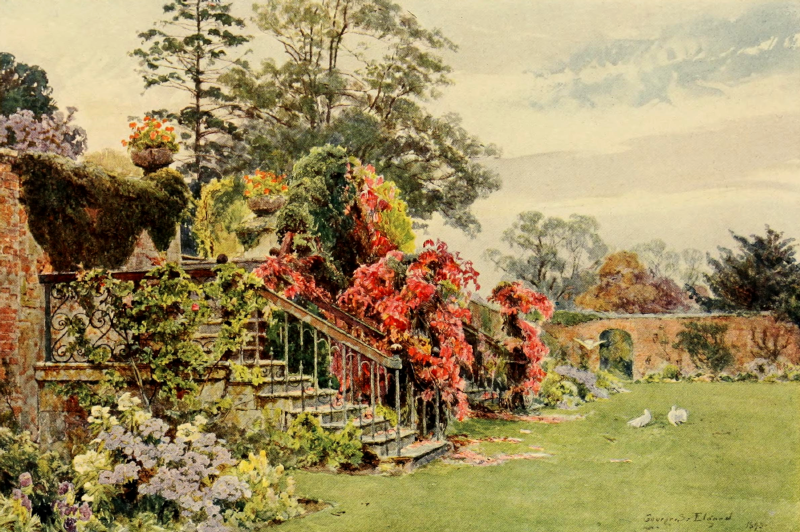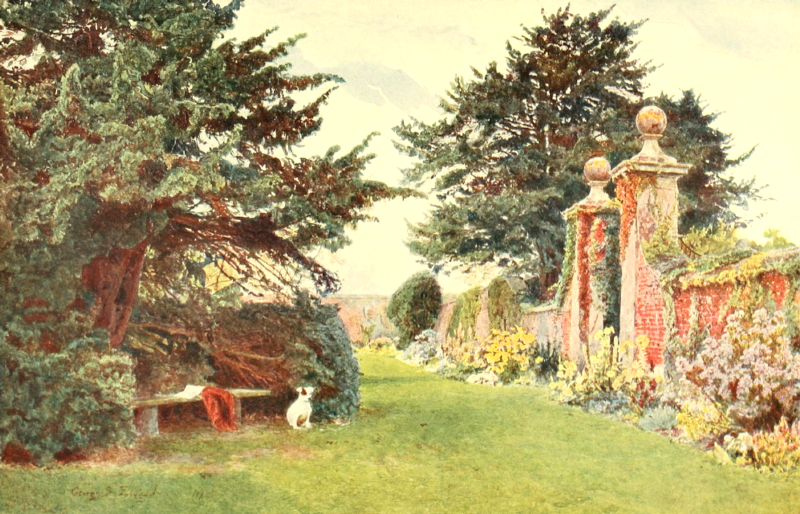| Web
and Book design,
Copyright, Kellscraft Studio 1999-2021 (Return to Web Text-ures) |
 (HOME)
|
|
BULWICK
HALL
 BULWICK: AUTUMN From the picture in the possession of Lord Henry Grosvenor Bulwick
Hall, in Northamptonshire, the home of the Tryon family, but, when the pictures
were painted, in the occupation of Lord and Lady Henry Grosvenor, is a roomy,
comfortable stone building of the seventeenth century. The long, low, rather
plain-looking house of two stories only, is entered in an original manner by a
doorway in the middle of a stone passage, at right angles to the building, and
connecting it with a garden house. The careful classical design and balustraded
parapet of the outer wall of this entrance, and the repetition of the same,
only with arched openings, to the garden side, scarcely prepare one for the
unadorned house-front; but the whole is full of a quiet, simple dignity that is
extremely restful and pleasing. Other surprises of the same character await one
in further portions of the garden. Passing
straight through the entrance gate there is a quiet space of grass; a level
court with flagged paths, bounded on the north by the house and on the east and
west by the arcade and the wall of the kitchen garden. The ground falls
slightly southward, and the fourth side leads down to the next level by grass
slopes and a flight of curved steps widening below. Trees and shrubs are
against the continuing walls to right and left, and beds and herbaceous borders
are upon the grassy space. The wide green walk, between long borders of hardy
plants, leading forward from the foot of the steps, reaches a flower-bordered terrace
wall, and passes through it by a stone landing to steps to right and left on
its further side. A few steps descend in twin flights to other landings, from
which a fresh flight on each side reaches the lowest garden level, some nine
feet below the last. The whole of this progression, with its pleasant variety
of surface treatment and means of descent, is in one direct line from a garden
door in the middle of the house front. The
lowest flight of steps, the subject of the first picture, has a simple but
excellent wrought-iron railing, of that refined character common to the time of
its making. It was draped, perhaps rather over-draped when the picture was
painted, with a glory of Virginia Creeper in fullest gorgeousness of autumn
colouring. This question of the degree to which it is desirable to allow
climbing plants to cover architectural forms, is one that should be always
carefully considered. Bad architecture abounds throughout the country, and
free-growing plants often play an entirely beneficent part in concealing its
mean or vulgar or otherwise unsightly character. But where architectural design
is good and pure, as it is at Bulwick, care should be taken in order to prevent
its being unduly covered. Old brick chimney-stacks of great beauty are often
smothered with Ivy, and the same insidious native has obliterated many a beautiful
gate-pier and panelled wall. But the worst offender in modern days has been the
far-spreading Ampelopsis Veitchii, useful for the covering of mean or
featureless buildings, but grievously and mischievously out of place when, for
instance, ramping unchecked over the old brickwork of Wolsey's Palace at
Hampton Court. Some may say that it is easily pulled off; but this is not so,
for it leaves behind, tightly clinging to the old brick surface, the dried-up
sucker and its tentacle, desiccated to a consistency like iron wire. These are
impossible to detach without abrasion of surface, while, if left, they show
upon the brick as a scurfy eruption, as disfiguring to the wall-face as are the
scars of smallpox on a human countenance. The
iron-railed steps in the picture come down upon a grassy space rather near its
end. Behind the spectator it stretches away for quite four times the length
seen in the picture. It is bounded on the side opposite the steps by a long
rectangular fish-pond. The whole length of this is not seen, for the grass walk
narrows and passes between old yew hedges, one on the side of the pond, the
other backed by some other trees against the kitchen garden wall, which is a
prolongation of the terrace wall in the picture.  BULWICK. THE GATEWAY From the picture in the possession of Lord Henry GrosvenorThe
garden is still beautifully kept, but owes much of its wealth of hardy flowers
to the planting of Lady Henry Grosvenor, whose fine taste and great love of
flowers made it in her day one of the best gardens of hardy plants, and whose
untimely death, in the very prime of life, was almost as much deplored by the
best of the horticultural amateurs who only knew her by reputation, but were
aware of her good work in gardening, as by her wide circle of personal friends.
She
had a special love for the flag-leaved Irises, and used them with very fine
effect. The borders that show to right and left of the steps had them in large
groups, and were masses of bloom in June; other plants, placed behind and
between, succeeding them later. Lady Henry was one of the first amateurs to
perceive the value of planting in this large way, and, as she had ample spaces
to deal with, the effects she produced were very fine, and must have been
helpful in influencing horticultural taste in a right direction. Another
important portion of the garden at Bulwick is a long double flower-border
backed by holly hedges, that runs through the whole middle length of the
kitchen garden. It is in a straight line with the flagged walk that passes
westward across the green court next to the house, and parallel with its garden
front. The flagged path stops at the gate-piers in the second picture, a grass
path following upon the same line and passing just behind the shaded seat. The
holly hedges that back the borders are old and solid. Their top line, shaped
like a flat-pitched roof, is ornamented at intervals with mushroom-shaped
finials, each upon its stalk of holly stem. The grass walk and double border
pass right across the kitchen garden in the line of its longest axis. At the
furthest end there is another pair of the same handsome gate-piers with a
beautiful wrought-iron gate, leading into the park. The park is handsomely
timbered, and in early summer is especially delightful from the great number of
fine old hawthorns. In
Lady Henry's time several borders in the kitchen garden were made bright with
annuals and other flowers. Such borders are very commonly used for reserve
purposes, such as the provision of flowers for cutting, with one main double
border for ornament alone. But where gardens are being laid out from the
beginning, such a plan as this at Bulwick, of a grass path with flower borders
and a screening hedge at the back, passing through a kitchen garden, is an
excellent one, greatly enlarging the length of view of the pleasure garden,
while occupying only a relatively small area. It is also well in planning a
garden to provide a reserve space for cutting alone, of beds four feet, and
paths two feet wide, and of any length suitable for the supply required. This
has the advantage of leaving the kitchen garden unencumbered with any flower-gardening,
and therefore more easy to work. Such
a long-shaped garden is also capable of various ways of treatment as to its
edge, which need not necessarily be an unbroken line. The length of the border
in question is perhaps a little too great. It might be better, while keeping
the effect of a quiet line, looking from end to end, to have swung the edge of
the border back in a segment of a circle to a little more than half its depth,
every few yards, in such a proportion as a plan to scale would show to be right;
or to have treated it in some one of the many possible ways of accentuation
where the cross paths occur that divide it into three lengths. The thinking out
of these details according to the conditions of the site, the combining of them
into designs that shall add to its beauty, and the actual working of them, the mind
meanwhile picturing the effect in advance — these are some of the most
interesting and enlivening of the many kinds of happiness that a garden gives. Be it large or small there is always scope for inventive ability; either for the bettering of something or for the casting of some detail into a more desirable form. Every year brings some new need; in supplying it fresh experience is gained, and with this an increasing power of adapting simple means to such ends as may be easily devised to the advancement of the garden's beauty. |